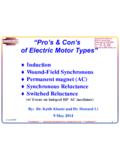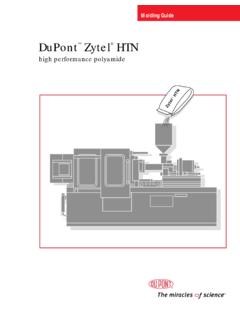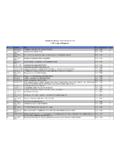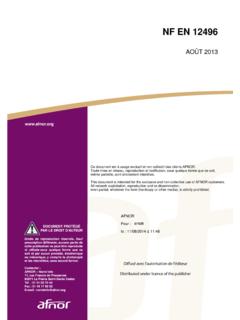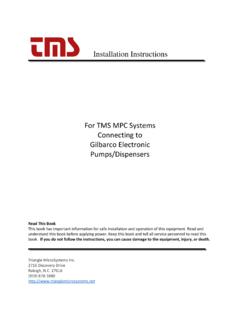Transcription of Carbon Brush Performance on Slip Rings
1 Carbon Brush Performance on slip Rings Richard D. Hall Morgan AM&T. Roland P. Roberge Morgan AM&T. Gary Lozowski Morgan AM&T. Mining Electrical Maintenance and Safety Association September 9, 2010 Clearwater, FL. Machines that use Carbon Brushes on slip Rings Carbon Brushes slip Rings Synchronous Motor or Generator Synchronous Motor Constant speed Very efficient Three phase windings in stator (rotating magnetic field). DC fields on rotor DC excitation supplied through Carbon brushes on two slip Rings (collector Rings ).
2 Synchronous Motor Typical Brush current density 75. Amps/in2 ( Amps/cm2) or less Collector Rings are generally Carbon steel or bronze Sync Motor Collector Rings Wound Rotor Induction Motor Variable speed Three phase windings in stator (rotating magnetic field). Three phase windings in rotor Three phase (variable frequency) current induced in rotor Rotor current brought out to variable resistance/electronic controls through brushes on three slip Rings to control speed Wound Rotor Induction Motor Typical Brush current density varies widely depending on motor design and application from about 75 Amps/in2 ( Amps/cm2) to 125 Amps/in2 ( Amps/cm2).
3 Collector Rings are most often bronze or stainless steel Wound Rotor Motor Three slip Rings Turbine Generator Turbine generator Brush rigging with change on the fly . removable Brush holders Turbine Generator Synchronous generator Extremely efficient Converts mechanical energy to AC electrical energy with steam or gas turbine as prime mover Three phase windings in stator (rotating magnetic field). DC Fields on rotor DC excitation supplied through Carbon brushes on two slip Rings (collector Rings ). Steam Turbine Generator Typical Brush current density 40.
4 Amps/in2 ( Amps/cm2) to 65. Amps/in2 (10 Amps/cm2). Collectors Rings are almost always steel or sometimes stainless steel Surface speeds up to 16,000 Feet per minute ( 182 MPH, 81 mps ). Brush Selection and Collector ring Filming Brush Material Selection Brushes and collectors form a sliding electrical contact Brushes are selected based on the current density, ring material and surface speed The original equipment supplier (OEM) will have selected grades, but grade changes may be made if the machine operates at conditions different than rated Typical Brush Materials Used Brush Material Rated Current Metal Content Density %.
5 Amp/in2 Amp/cm2. Graphite 65 0. Electrographite 80 0. Copper Graphite 100 50. Copper Graphite 125 75. Brush Wear Mechanical Frictional wear Electrical Material removed with the flow of current Thermal With heat some Carbon oxidizes into CO2. Film provides a low friction surface Common Collector ring Materials Bronze Resistance to chemical reactions. Limited speed capability. Good friction characteristics. Steel Good mechanical strength. Can oxidize under Brush at standstill or rust Stainless steel Contamination resistance.
6 May have higher Brush contact drop and selectivity Brush Holders Brushes must be held in contact with the ring for good Performance The holders must be supported so they do not vibrate Clock spring holders are a poor selection where there is vibration and must be adjusted as brushes wear Constant pressure holders are common on newer machines or retrofits Adjustable Clock Spring Clock Spring Holders A Different Style Adjustable Spring Ladder Back Holder Short Style Brush Holder Not Preferred Full Length Brush Holder Preferred Brush Holder Alignment and Design Concerns Constant Pressure Springs Constant Pressure.
7 (Non-Adjustable). Spring Brush holders set too high Brush holder clearance to the Rings should be set to manufacturer's recommendation. This is typically about ( 1/8 ) maximum Brush Holder A longer holder would be better for Brush stability Brush Holder alignment OK, exactly perpendicular to the slip ring surface or commutator surface slip ring or Commutator Rotation Brush Holder alignment , not the best, but 1 or 2. degrees trailing is OK. slip ring or Commutator Rotation Brush Holder alignment needs adjustment.
8 This is called leading or stubbing and can cause fast wear or friction chatter. Just 1 or 2. degrees makes a big difference. slip ring or Commutator Rotation Not Good One Brush trailing, one leading Normal Performance Uniform film appearance with no burn marks No signs of excessive ring wear No visible sparking Brush faces uniform with no sign of burning Minimal side polish . from Brush movement Good Brush life Two excellent tools for accessing Rings Feeler Stick Strobe Light Collector condition for good Performance Total Indicator Runout Inches (micron).
9 Preferred (25). Allowable (76). Surface speed and type of TIR affects Brush Performance ..00044 TIR. 3600 RPM. slip ring .00044 TIR. 3600 RPM. slip ring u sh Br Small BUMP on slip ring OD may .00044 TIR. cause problems 3600 RPM. slip ring p g 1. 200. 20. 180 3 ring 40. slip ring Assembly 160 Each ring has 60. a different Profile 140. 80 See next 2 slides 120 100. Profiler MAS - slip ring - Radial Plot 1. 220. 20. 200. 40. 180. 60. 160. 80. 140. 100. 120. 20 00 20 20 00 20. Profiler MAS - slip ring - Radial Plot 1.
10 200. 20. 180. 40. 160. 60. 140. 80. 120. 100. 20 00 -2 0 -2 0 00 20. Collector ring Conditions Foot Printing (photo Imaging/ghosting). Images appear on the ring that initially reflect the size of the Brush face and Brush spacing Erosion from arcing makes low spots . The marks may spread out over time and make the ring surface not round Sometimes the ring looks like the Brush is bouncing or skipping Foot Printing Turbine Generator Photo Imaging - Advanced Foot Printing Simultaneous loss of contact The initial trigger is a mechanical disturbance The damage to the ring is from subsequent electrical erosion Eventually, the initial marks may spread out and not be visible.
